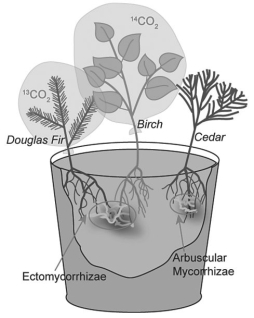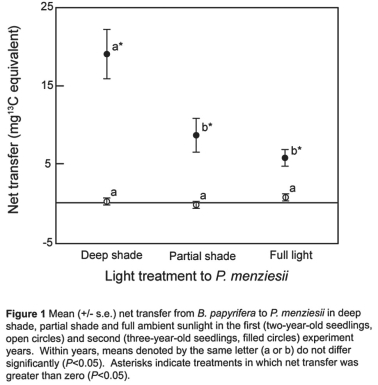Multiple Choice
Use the following information when answering the corresponding question(s) .
Suzanne Simard and colleagues knew that the same mycorrhizal fungal species could colonize multiple types of trees.They wondered if the same fungal individual would colonize different trees,forming an underground network that potentially could transport carbon and nutrients from one tree to another (S.Simard et al.1997.Net transfer of carbon between mycorrhizal tree species in the field.Nature 388:579-82) .Figure 31.2 illustrates the team's experimental setup.Pots containing seedlings of three different tree species were set up and grown under natural conditions for three years;two of the three species formed ectomycorrhizae (Douglas fir,birch) and the other (cedar) formed arbuscular mycorrhizae.For the experiment,the researchers placed airtight bags over the Douglas fir and birch seedlings;into each bag,they injected either carbon dioxide made from carbon-13 or carbon-14 (¹³CO₂ and ¹⁴CO₂,isotopes of carbon) .As the seedlings photosynthesized,the radioactive carbon dioxide was converted into radioactively labeled sugars that could be tracked and measured by the researchers.
Figure 31.2

Figure 31.3

-Refer to Figure 31.2.Which of the following results would support Simard et al.'s (1997) hypothesis that fungi can move carbon from one plant to another? Hypothesis:
Sugars made by one plant during photosynthesis can travel through a mycorrhizal fungus and be incorporated into the tissues of another plant.
A) Carbon-14 is found in the birch seedling's tissues and carbon-13 in the Douglas fir.
B) Carbon-14 is found in the Douglas fir seedling's tissues and carbon-13 in the birch.
C) Either carbon-13 or carbon-14 is found in the fungal tissues.
D) Either carbon-13 or carbon-14 is found in the cedar seedling's tissues.
Correct Answer:

Verified
Correct Answer:
Verified
Q8: Why is it important that ectomycorrhizal fungi
Q10: At which stage of a basidiomycete's life
Q13: Figure 31.5<br>Use the graphs in Figures 31.4
Q14: Which of the following is an important
Q16: Microsporidians are considered parasitic because of the
Q17: Figure 31.4<br>Use the following information when answering
Q20: This group of fungi has the ability
Q21: Basidiomycetes are the only fungal group capable
Q22: Which fungal class is not matched with
Q23: Figure 31.5<br>Use the graphs in Figures 31.4